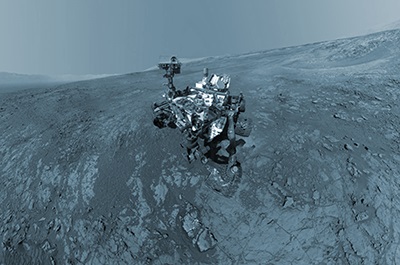
DIGES is a research project between the Italian Space Agency (ASI) and the Politecnico di Milano (POLIMI) aimed at developing a preliminary design of a Digital-Twin (DT) model of space rover systems for lunar surface exploration.
Space exploration has always been of interest equally for the scientific and civil society for both its inner charm, which always nourished the human fantasy, and for the scientific opportunities that from it might arise.
Among the different phases of space exploration, the analysis of the surface of those celestial objects plays a central role, both for a greater understanding of the formation of the solar system and the universe in general, and for the ancient desire of man to find traces of new life forms.
In this context, the Moon was the first target of a space exploration, which, more recently, has also extended to other celestial bodies, in particular through the use of rovers (think for example of the exploration of the surface of Mars).
Rovers allow exploring the surface by collecting samples of scientifically valuable material, such as ambient images and data, rock samples, etc. Clearly, the role played by the rovers has become crucial and that their reliability is fundamental to the success of the mission itself. Nowadays, the high complexity and costs of these exploration platforms call for high reliability and efficiency, even operating autonomously. In fact, the possibility of unexpected failures, anomalies, or performance degradation (usually unavoidable) could give rise to consistent losses and catastrophic consequences, especially due to the impossibility of direct human interventions.
In order to avoid that failures or anomalies compromise the success of the mission, the scientific community, supported by the industries of the sector, recently developed a series of advanced technologies that can be applied to the remote and real-time health monitoring of the rover. Among others, the development of a detailed DT model of the system turns out essential, being able to accurately reproduce the operation of the rover, and to simulate the signals acquired through the on-board sensors, by modeling the multi-physical interactions between the different subsystems, thus allowing a more informed management of the system throughout its life cycle operating.
To this aim, the research group of the Department of Mechanical Engineering will provide its major contribution. Leveraging on the activities carried out in the past, our research group has already developed Health and Usage Monitoring Systems (HUMS) for complex platforms applications, especially for the aeronautical industry. This methodology makes use of DT models, which in the DIGES project can be used in order to optimize both the design of the systems and their operational management. In particular, the methodology can be used in different stages of the rover's life, including:
- the design phase;
- the testing phase;
- the operational and decision-making phase of the mission;
- the residual life optimization phase.
The project therefore proposes the preliminary development of a DT architecture for a rover-type space system for lunar exploration. This DT will be based on the creation of multi-physical models, representative of the spatial system, to be used for the generation of characteristic patterns useful for the interpretation of the signals acquired in real time, both in healthy and damaged / anomalous conditions. These will be processed by artificial intelligence algorithms and, more generally, by statistical signal processing, in order to return a real-time “photograph” of the system. In this context, three main project objectives will ensure the future implementation of the technology on real platforms:
- the model must have a relatively low computational weight allowing real-time access, possibly through the implementation of surrogate models;
- the model must be able to adapt immediately and autonomously to the inevitable changes occurring during operation phases, which will be possible via the implementation of model-updating/filtering algorithms;
- the model must be able to interact with other DT models, as those related to other space modules or representing the interaction with the lunar surface, etc.
The achievement of these objectives is expected to ensure faster planning and greater reliability of future missions to explore the lunar soil and other celestial bodies in general.
The project is coordinated by the multidisciplinary research group of the Department of Mechanical Engineering of the Politecnico di Milano, with strong experience in project management in the field of monitoring and prognostics of mechanical and aerospace structures and systems. The research team is made up of Prof. Marco Giglio, Prof. Claudio Sbarufatti and Prof. Francesco Cadini, active in the fields of multi-physics modeling and artificial intelligence, and will also involve PhD students, MSc students and researchers.
